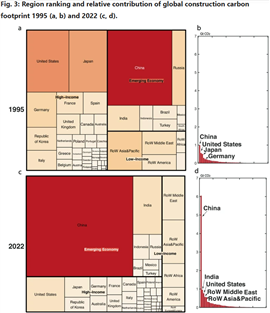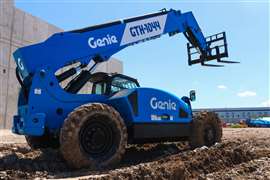Read this article in Français Deutsch Italiano Português Español
Global construction’s carbon footprint to more than double by 2050
10 November 2025
 Image: Touch1996 via AdobeStock - stock.adobe.com
Image: Touch1996 via AdobeStock - stock.adobe.com
The global construction industry’s carbon footprint is set to more than double by 2050.
That’s according to a new study published in Nature’s Communications Earth & Environment, which warned that construction’s carbon footprint alone would be enough to exceed the per-annum carbon budget to hold global temperatures below 2˚C over the next two decades.
It warned that in 2022, over half of the construction industry’s carbon emissions came from cementitious materials, bricks, and metals. Glass, plastics, chemicals, and bio-based materials contributed 6%, and the remaining 37% arose from transport, services, machinery, and on-site activities.
It also found that the construction industry’s carbon footprint in global emissions has gradually increased over three decades, from 20% to 33%, fuelled mainly by material-related inputs such as cement, bricks, metals and glass.
The study called for a “material revolution” that would involve replacing traditional materials with bio-based, circular, and reused materials.
In total, the construction industry generated 12.2 gigatonnes (Gt) of CO2, with cement the primary contributor. In 2022, cement alone accounted for more than a quarter (28%) of the construction industry’s total carbon footprint. Cement, clinker, bricks, and clay together contribute 40% of the construction industry’s total carbon emissions, while metals account for 15%, half of which comes from steel.
In spite of attempts to offer lower-carbon versions of these materials in developed economies in recent years, the study identified a “shift toward increasingly carbon-intensive and less sustainable material use”.
A major reason for the increase has been a rapid rise in the number of major construction projects in developing regions. Between 1995 and 2022, Africa, Brazil, and China saw a significant increase in carbon footprint embodied in what the report termed “unsustainable construction material” (cement, clinker, steel and other metals).
In China, for example, unsustainable construction materials accounted for 43% of its construction carbon footprint. By 2022 that had risen to 73%.
In developed regions, the footprint of unsustainable materials remained relatively stable.
Meanwhile, there was also a reduction in carbon footprints embodied in biobased materials like wood, straw, and other natural products over the same period. In China, biobased materials comprised 4% of the country’s total carbon footprint in 1995 but that had fallen to 0.5% by 2022.
 a, c The relative contribution of global construction carbon footprint for high-income regions, emerging economies, and low-income regions in 1995 and 2022. b, d Country ranking for the carbon footprint for the construction industry in 1995 and 2022. (Source: Li, C., Pradhan, P., Chen, G. et al. Carbon footprint of the construction sector is projected to double by 2050 globally. Commun Earth Environ 6, 831 [2025].)
a, c The relative contribution of global construction carbon footprint for high-income regions, emerging economies, and low-income regions in 1995 and 2022. b, d Country ranking for the carbon footprint for the construction industry in 1995 and 2022. (Source: Li, C., Pradhan, P., Chen, G. et al. Carbon footprint of the construction sector is projected to double by 2050 globally. Commun Earth Environ 6, 831 [2025].)
Call for ‘urgent transition’ on building materials
Noting that the construction industry is “widely regarded as one of the most difficult industries to decarbonise”, the study called for an urgent transition to low-carbon construction to reduce the sector’s carbon footprint.
It suggested, “A starting point on the supply chain side could be investing in capital assets such as machinery and infrastructure for new construction alternatives. The investment sector is a good starting point for bringing turnarounds, as it can lead to scale effects through reducing production costs.
“Currently, a major barrier to innovative solutions such as bio-based materials is the lack of adequate supply chain infrastructure. Traditional construction machinery is often unsuitable for bio-based materials, requiring different handling techniques. Furthermore, we show that the capital asset sector is one of the largest sub-sectors contributing to the supply chain footprint in the construction sector. Making changes in the capital asset sector, therefore, has the double dividend in that it has the potential to induce scale effects and, at the same time, directly target the second-largest contributor in the supply chain of carbon emissions in the construction industry.”
It also highlighted the importance of regional differentiation, pointing out that while high-income regions may transition towards circular construction, modular design, and material innovation, fast-growing cities in the Global South may instead need low-cost, scaleable, locally sourced solutions.
When it comes to reducing reliance on traditional materials like cement, steel, and bricks study suggests biobased materials or alternatives to traditional Portland cement, such as alkali-activated materials. But scaling these alternatives requires “robust evaluation of their carbon intensity, durability, availability of precursor materials, and compatibility with existing building codes”, it noted.
There are also potential trade-offs between scaled-up use of timber or bamboo and deforestation and biodiversity that require further evaluation it noted.
Building codes would also have to be updated to recognise the safety and durability of biobased options.
Meanwhile, Exergio, a company that develops AI-based tools for energy efficiency in commercial buildings, wanted that the problem doesn’t stop at the construction site.
““When buildings become operational, energy waste happens quietly: we see that heating and cooling systems start working against each other, sensors give inaccurate readings, and rooms stay heated or cooled long after people leave. Those losses add up fast,” explains Donatas Karčiauskas, CEO of Exergio. “The same inefficiency that starts in material production continues in operation. It just changes form.”
“Switching the world’s building stock to new materials will take decades and cost trillions – and even then, buildings would still waste 40% of global energy,” he said. “We already have a faster fix. Optimising how systems run can cut up to 30% of that waste now, without rebuilding anything.”
The study, co-written by academics in China, Germany, the Netherlands and Austria, was supported by the European Research Council, China Scholarship Council, the National Natural Science Foundation of China, and the European Union’s Horizon 2020 research and innovation programme.
STAY CONNECTED


Receive the information you need when you need it through our world-leading magazines, newsletters and daily briefings.
CONNECT WITH THE TEAM










